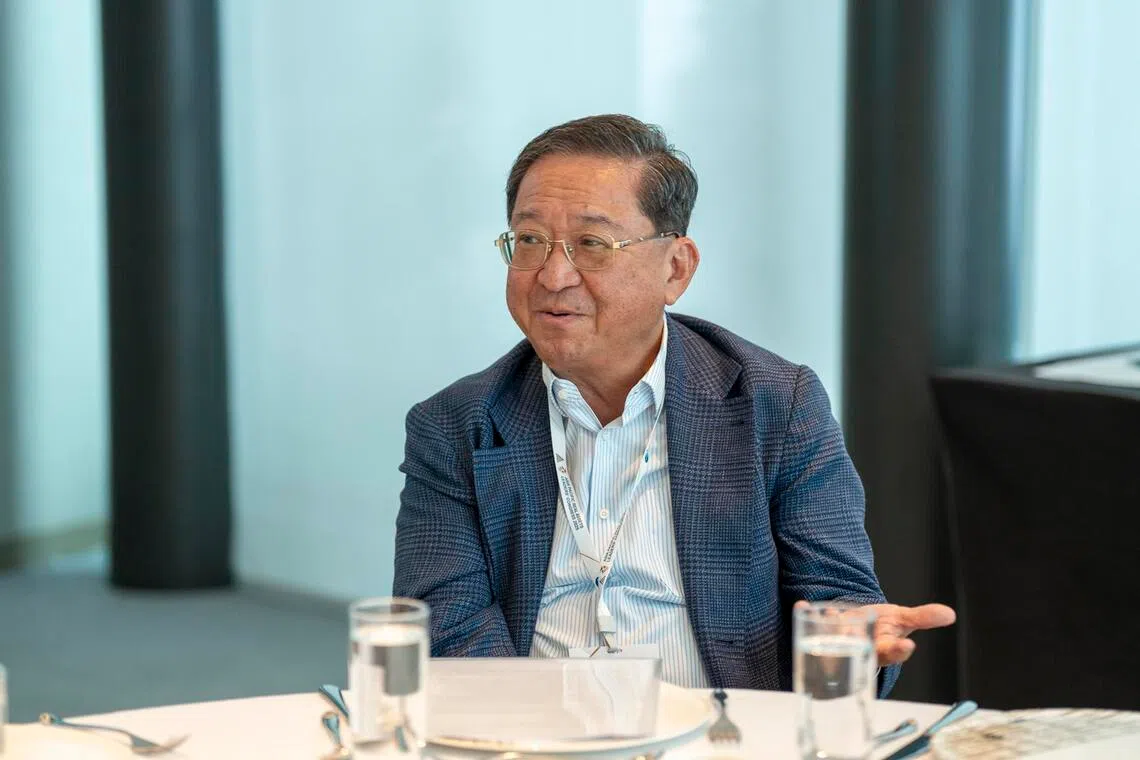Reits in Singapore and the region stage a comeback, delivering 16% returns since January
Sign up now: Get ST's newsletters delivered to your inbox

Falling interest rates offer the best scenario for the real estate sector and Reits, said Aprea chairman John Lim.
PHOTO: ASIA PACIFIC REAL ESTATE ASSOCIATION
Follow topic:
SINGAPORE - Real estate investment trusts (Reits) are staging a comeback as improved market sentiment and lower interest rates paint a brighter outlook for deal-making and initial public offerings in Singapore and the Asia-Pacific.
After battling challenges posed by Covid-19, the macroeconomic picture is improving along with investor demand.
This has helped two Reits – NTT DC Reit and Centurion Accommodation Reit – to list on the Singapore Exchange in 2025 and raise a combined $1.8 billion, with more in the works.
Reits in the Asia-Pacific have delivered total returns of almost 16 per cent since the start of 2025, according to Global Property Research and Asia Pacific Real Assets Association (Aprea) Reit Composite Index, which tracks listed Reits in the region.
“I believe Asia-Pacific Reits have hit the bottom and are pivoting and riding on the capital market buoyancy. When capital markets run, real estate will follow,” Aprea’s chairman John Lim told the press on Oct 9.
Falling interest rates offer the best scenario for the real estate sector and Reits, he added.
Reits – trusts that own and operate income-generating properties from shopping malls to offices to hospitals – are sensitive to fluctuations in interest rates as many fund their operations with loans.
A fall in interest rates would mean loans may be refinanced at lower cost, which could then boost bottom lines, allowing them to invest in new properties and spur growth.
The outlook is bright with the US Federal Reserve expected to continue lowering its key rates.
Mr Lim, 69, whom Forbes estimates is worth US$1.2 billion (S$1.56 billion), is a well-known pioneer of Reits in Singapore and Asia.
At age 45, he co-founded real estate fund manager ARA Asset Management in 2002 with the backing of Hong Kong billionaire Li Ka-shing. ARA was listed in Singapore in November 2007.
In 2016, Mr Lim, together with US private equity firm Warburg Pincus and China’s Avic Trust, took ARA private in a US$1.3 billion buyout.
In 2021, Hong Kong-based real asset manager ESR Group announced plans to buy ARA for US$5.2 billion in stock and cash.
In July 2025, a consortium led by Starwood Capital Group and other investors took ESR private from the Hong Kong stock exchange in a deal that valued it at US$7.1 billion.
Mr Lim sold his stake in ESR and resigned from the board. He is now the chairman of his JL Family Office.
The rebound in major Asia-Pacific Reits has been broad-based, with several markets, including Singapore, Australia and Japan, delivering double-digit returns, said Ms Sigrid Zialcita, Aprea’s chief executive.
Hong Kong emerged as the top performer with 25.4 per cent returns since January. In comparison, US Reits have lagged most of the region’s Reits with a modest 4.6 per cent return, highlighting the gap in sentiment, she said.
Easing monetary policies across Asia have cut borrowing costs and improved liquidity, creating a conducive environment for real estate investment.
Investors seeking stability amid global uncertainties are also turning to Reits, Ms Zialcita said.
Valuations are compelling, with a number of markets trading at yields of over 5 per cent, offering predictable income streams that appeal to both institutional and retail investors, she said.

The rebound in major Asia-Pacific Reits has been broad-based, with several markets, including Singapore, Australia and Japan, delivering double-digit returns, said Ms Sigrid Zialcita, Aprea’s chief executive officer.
PHOTO: ASIA PACIFIC REAL ESTATE ASSOCIATION
Average yield spreads in China, Hong Kong and Singapore are also among the widest, compared with the US, which reinforces the region’s appeal as a defensive play, Ms Zialcita added.
She noted that Reit portfolios have expanded beyond traditional office and retail properties to include logistics, data centres and living spaces.
While acquisition activity remains modest amid cautious capital deployment sentiment, the IPO market is reviving after a prolonged drought, she said.
In the year to date, Asia-Pacific Reit IPOs have raised US$7.6 billion, setting the stage for a new expansionary phase.
More than half of the capital raised was for China Reit listings, which have expanded rapidly.
The Asia-Pacific Reit market now boasts a combined market capitalisation of US$437 billion.
China is seen as the fastest-growing regime, with 75 Reits worth more than US$31 billion listed on exchanges there.
In comparison, S-Reits’ market capitalisation is about US$83 billion and Hong Kong’s Reit market value is US$19.2 billion.
China’s Reit market could potentially grow to be as big as the US Reit market, which has a market value of US$1 trillion, said Mr Lim, who noted that in the mainland, office and hotel assets may be ripe for Reits.
The potential could be unleashed by the China-Hong Kong Stock Connect initiative to include Hong Kong and China-listed Reits – a move that will expand the investor base and trading liquidity of the Reits listed in both areas.
Reits are also gaining traction in India, which had introduced small and medium (SM) Reits in March 2024.
India already has 300 million sq ft of SM Reit-ready office space, with another 50 million sq ft likely to come by 2026, according to analysts.
SM Reits present a potential opportunity of more than US$60 billion by 2026, they said.
Unlike traditional Reits, India’s SM Reits focus on small and medium-sized assets like standalone office buildings and warehouses of sizes less than 100,000 sq ft.
Despite the potential seen in China’s and India’s Reit markets, Mr Lim said that in Asia, asset owners hardly sell trophy or pride assets.
For instance, in Hong Kong, many assets are tightly held by tycoons, not institutions. “The biggest fear is owners dumping lousy assets into the Reit market and the retail investors get hit down the road, along with confidence in the market,” he warned.


